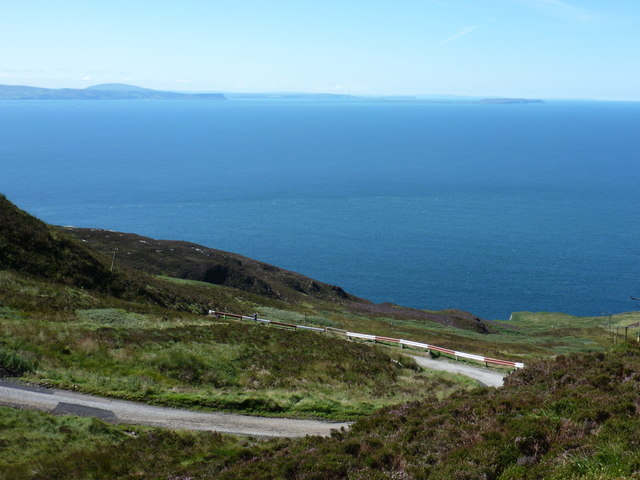The Highest Railway In Ireland

The cuttings, embankment, and bridges of the old narrow-gauge railway from Ballymena to Retreat Station are still visible reminders of an unusual if unprofitable service. It was called the Ballymena, Cushendall and Red Bay Railway (BCRR) and it was the first narrow-gauge railway to be authorised by Parliament. It was opened firstly for goods from Ballymena to Cargan in 1875 and then extended to Retreat in 1876. Here the line ended abruptly some four miles from Cushendall some 800 feet above the sea. In 1875, Parliament sanctioned a branch up the Braid Valley from Broughshane to Bruckna but the proposal in 1879 to extend the branch line to Carnlough and Glenarm was not supported and the Braid Valley Railway was never built.
The BCRR‘s original purpose was to carry iron ore from Parkmore and Cargan and some of these branches were owned by the mining companies. It also provided the best means of travelling to the Glens of Antrim, as it connected with the mainline at Ballymena. The iron ore mines in the mid 19th century were busy and in the early days of the single line, railway paid dividends. But when the iron ore boom passed and the mineral traffic declined and with so the old B.C.R.R. was absorbed by the Belfast and Northern Counties Railway in 1884. The little railway engine climbed steadily from Ballymena, skirting the foothills of Trostan [the highest mountain in the county], and eventually rising to a siding, which was 1,045 feet above the sea level, the highest point in Ireland ever reached by train. Very little interest is taken in its history. It ceased to run in 1935 and I found it difficult to obtain information about its day-to-day working and old photographs, timetables, tickets that do not appear to exist.
The remains of the station house still stand at Parkmore, here the passengers alighted from the little carriages and finished their journey by Jaunting cars. It was a pity the line ended halfway up the steep slope of Lurigeadean [Lurig to the glens man] towering over Cushendall, the little capital of the Glens. The passengers would have had of the North Channel and beyond Scotland and the Mull of Kintyre is unrivalled. Another charming little railway was the Antrim to Drapers town. This line passed through Randalstown, which still possesses one of the most magnificent stone bridges in our island, then skirting the Lough Neagh shore in a semi-circle in a semi-circle, it passes through Toomebridge, Magherafelt and ends in Draperstown, pushing its way into the heart of the Sperrin Mountains.
The Ballycastle –Ballymoney narrow gauge railway line, which opened in 1880 by a private concern –the Ballycastle Railway Company had a troubled 70 years of history because it never really paid its way.
I recall reading a charming little book nearly 40 years ago called simply ‘The Ballycastle Railway’. A story within it recalls the time when the Sheriff seized three of the company’s railway carriages and advertised them for sale in order to meet the debts of the company. It turned out the carriages, did not belong to the company, so the Sheriff had to return them and seized instead a quantity of coal and 70 tons of rail!
The independent company which owned the railway closed in 1923 and the line was taken over shortly afterwards by the L.M.S. Company, which carried on business till the 2nd July 1930 when the little narrow-gauge railway made its last journey. In the book, it is reported that the line might have survived for another few years because a scheme for re-gauging the line from narrow to broad was seriously considered. The scheme foundered because of the 66-yard long Capecastle tunnel. The bore of the tunnel was not sufficient to take broad-gauge lines and it was eventually concluded that the cost of enlarging it could not be justified.
The most spectacular journey the little train ever made was in January 1943. On the down-gradient approaching Ballycastle, the brakes failed to hold and the train ran away. It went through the buffer, crossed the railway, went through another fence and finally ran down a bank into a small stream. The astonishing thing was that the engine and carriages remained on their wheel; whilst the passengers and crew have badly shaken no one was badly hurt. Many a time I travelled on this line to visit my maternal grandmother who lived in Ballycastle. The two working engines were simply known as Numbers 41 and 42. Between them, it is reckoned they covered over one and a half million miles. Fittingly, they were used as a team when the little train made its last journey in 1943.
J.J Tohill
If you enjoyed this blog, click here to view more from us!
With Happy Ireland Productions, you can preserve your memories to last forever. Visit one of our partners to drop off your assortment of tapes, film, pictures and audio keepsakes. You’ll receive your DVD or digital copy with the original. Simple and Safe!
Your memories are priceless so why risk losing them.
Learn more about Happy Ireland Productions or Contact us for any inquiries